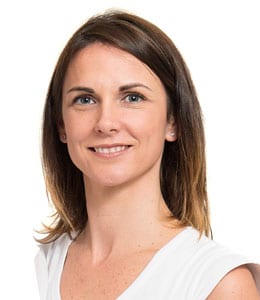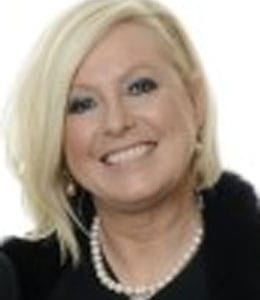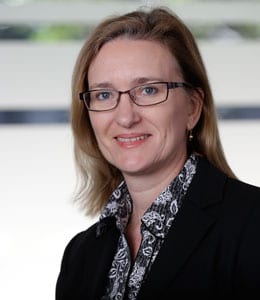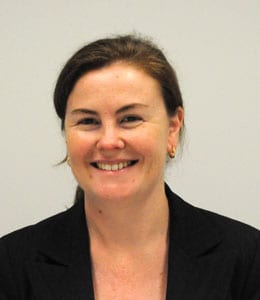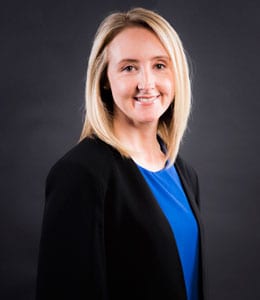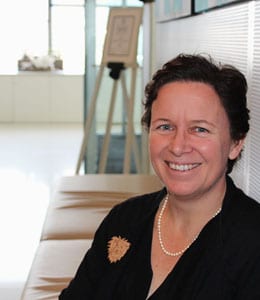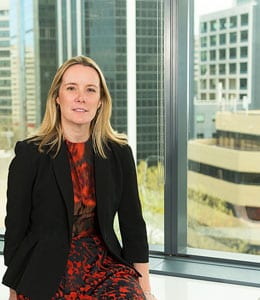
This is the second year that ProfessionalMums.net and Women’s Agenda have researched and published the Part-Time Power List, a list of people that work in leadership positions at large organisations in a flexible or part-time role (check out the 2014 list here).
See Kate Mill’s introduction to the list, including how it was researched, here.
2015’s Most Powerful Part Timers
1. Michelle Bain
Role: Associate General Counsel, Corporate Advisory
Company: Suncorp
Working pattern: 4 days, flexibly. Leaves early to spend evening with family and logs-in remotely as needed.
Career path: Offered a secondment as Associate General Counsel just when she found out she was expecting her third child. Michelle stepped out of a comfort zone and acquired new skills. On her return from parental leave this year, she was offered a permanent Associate General Counsel role leading the Corporate Advisory team.
2. Petrea Bradford
Role: General Manager Solar and Asia Renewables International Division
Company: Origin Energy
Working pattern: 4 days/week in the office. The hours are somewhat flexible spread over the week and take into account time for early morning and late night calls to South America and Asia. It also involves international travel every 4-6 weeks
Career path: Spent several years setting up and running a substantial trading portfolio around carbon and renewable energy and developing with the retail team a range of green product choices for our customers. Petrea later enacted the strategy to build the wind (power) portfolio for Origin. This resulted in a number of acquisitions including Cullerin Range wind farm and a 1500-megawatt development portfolio. She was closely involved in the national debate on climate change contributing to the development of policy around carbon trading and renewables and subsequently attended the Prime Minister’s Australia 2020 Summit. Petrea recently managed Origins joint venture activity in Chile, Indonesia, USA and PNG.
3. Caroline Beattie
Role: Senior Manager, Corporate Development
Company: AGL
Working pattern: Four days a week for the last four years
Career path: Worked in Investment Banking prior to joining AGL 13 years ago. At AGL she initially worked in the company’s retail marketing team before moving to work on mergers and acquisitions (M&A) for the past 8 years. She says: “Returning to work after the birth of my first child, I was unsure if flexible employment arrangements would work for my area of expertise (M&A) as the hours can be very demanding when busy. However, experience has shown it can, and does, work really well for me. Flexible working arrangements have allowed me to proactively balance the responsibilities of a demanding position with my personal commitments. More broadly, flexible work lets me progress my career in an area that I love and continues to challenge me, and I am supported to be successful with the things that are important to me outside of work – my young family.
“Key to this success has been having a manager who recognises flexible working is an important choice for me and honours our agreement that I will generally work a 4-day working week. I find I rarely work outside my four nominated workdays and my manager and colleagues respect this. There is also flexibility on start/finish times that allows for child care arrangements when required.”
What needs to change? Adopt a consistent approach across the business to flexible working. Many companies have flexible working policies in place but they are not always applied consistently. Often this comes down to leader capability and confidence—helping leaders to understand the policy and how to successfully manage flexible workers would make a difference. Sharing success stories helps too.
4. Samantha Daly
Role: Partner
Company: McCullough Robertson Lawyers
Working pattern: 4 days a week, with one day from home
Career path: Samantha has worked in the planning and environment sector for ten years. Her clients span across all levels of government as well as the property, energy and resources industries. Samantha was appointed a Partner at McCullough Robertson in 2013 at the age of 31 and is a foundation member of the firm’s Diversity Initiatives Committee. She is a role model to all women lawyers in and outside the firm, and exemplifies how to successfully work flexibly and be an outstanding and highly respected lawyer. NSW Minerals Council Director of Industry and Environment, David Frith says this about Samantha, “Samantha has achieved her career success while raising a young family. Her flexible work practices have had no impact on her work; in fact she remains the most responsive partner in a law firm that the NSW Minerals Council deals with.”
What needs to change? Organisations need to better promote what options are available to employees in relation to flexible work. They need to be viewed as a norm as opposed to an exception. Training must be run both at the staff and supervisor level.
What could government do better? Whilst the debate is far from over, I think discussion around the policy relating to paternity leave needs to be further explored. More policy needs to be implemented to allow sharing of the child-care responsibilities similar as to in the Scandinavian countries. The other ongoing issue relates to the availability and flexibility of childcare services to parents returning to work.
5. Lizzie Dennis
Role: Senior Legal Counsel
Company: Dulux Group Limited
Working pattern: Currently working two days per week in the office in the role of Senior Legal Counsel providing legal support to our Yates and Asian businesses. When I returned from maternity leave in March 2014 I was working three days per week in the role of Assistant Company Secretary.
Career path: Began working at DuluxGroup in 2009 in the role of Legal Counsel within the then Orica Consumer Products business. When DuluxGroup demerged from Orica and listed on the Australian Stock Exchange, she moved into the role of Senior Legal Counsel and Assistant Company Secretary.
What needs to change? The main challenges are (1) the difficulty in changing the perception of flexible work as relating to women, and (2) the impression that flexible work somehow makes you are less committed, and (3) how “unfair” it is that some are afforded the luxury of flexibility whilst others aren’t. Whilst this cultural shift needs to come from the top down, it takes time for what is often seen as a new and “radical” ideology of how work can be done to filter down through an organisation and become accepted by all.
To overcome the issues of perception organisations need to communicate the success of flexible work practices better and ensure that employees know they are open to everyone. The benefits and successes of flexible work practices should be talked about, using real examples and showing how they work on a practical level for not just women returning from maternity leave, but for all employees, and using a range of flexible work practices. Better communication of flexible workplace success stories will also go towards organisations adopting the view that employees can be heard (and effective and productive) without necessarily being seen. If this idea gains momentum, then the culture can shift and those who work flexibly can be “accepted”.
6. Louise Dwyer
Role: Executive General Manager, Personal Insurance, Human Resources
Company: Suncorp
Working pattern: Part time for the last 21 years; currently working four days in the office and half a day at home
Career path: Both business and HR roles. When returning from maternity leave, she deliberately chose roles that would broaden her capability and skill set so that she could increase her hours and climb the corporate ladder.
7. Georgina Gaussen
Role: Chief Procurement Officer
Company: News Corp Australia
Working pattern: 0.90 FTE In the office Mondays, Tuesdays, Wednesdays and Fridays, work remotely on a Thursday. Thursday mornings I volunteer at my children’s school, providing reading support to children. Obviously I find this time of the week very rewarding and am able to show my face at school!
Career path: Fellow Chartered Accountant, started my career with KPMG. Spent 12 years with Qantas Airways in senior roles including Head of Strategy, Head of People Shared Services and CEO of the Qantas Foundation.
What needs to change? Invest in smart technology that allows staff to dial into video conferences easily, share documents easily and work remotely. Senior female leaders need to lead by example and set the trend. Reward based on delivery rather than physical presence.
What could government do better? More formalisation of targets set in relation to women in senior roles or Board positions. Measurable metrics i.e. .ASX listed companies to report back on statistics re number of females interviewed, offered roles, number of flexible arrangements in place.
8. Karin Halliday
Role: Manager, Corporate Governance
Company: AMP Capital
Working arrangements: Work in the office 4 days a week, with flexible start and finish times
Career path: Karin has worked at AMP Capital for over 31 years. She has held a variety of senior investment roles, including almost 10 years in portfolio management and 15 years in corporate governance.
What needs to change? I do believe the greatest inroads will only be made when all organisations treat (and perceive) men and women equally with regard to the opportunity to work flexibly.
9. John Hancock
Role: General Manager, People and Culture
Company: Origin Energy
Working pattern: 4 days, flexibly
Career path: Variety of senior HR roles globally with BHP and then Vodafone, predominately in Europe. At Origin led its HR Transformation program over seven years. After working for Origin for four years, John took a six-month career break in 2012 when his first daughter was seven months old to become her fulltime carer. John’s wife travels for work, so it is important his role allows him to takeover full-time parenting duties when she’s away.
What could government do better? I know first-hand how issues such as childcare availability and affordability can affect returning to work after having a baby. Many parents already feel anxious about leaving their children to return to work to also have to contend with whether it makes economic sense, which impacts the broader economy and affects an organisation’s ability to retain talent. Like many other families, we use a combination of daycare and nannies. It would be great to see the government address the shortage of quality daycare places, as well as making it more affordable for the majority of working parents.”
10. Name: Jacky Hodges
Role: Acting General Manager, Industry Statistics
Organisation: Australian Bureau of Statistics
Working pattern: Working between Sydney and Canberra on a part time basis following a period of maternity leave
What needs to change? Value the skills and experience rather than time at the desk and challenge perceptions of part time work Make part time work actually part time, not just a full time job chopped in half.
11. Kelly Jones
Role: General Manager, Property Council Academy
Organisation: Property Council of Australia
Working arrangements: Kelly works 4 days a week, flexible hours, mostly in the office but works from home on occasion. Leads a team of people who all work part-time.
Career path: Kelly has been a driving force behind the Property Council Academy, the educational arm of the Property Council of Australia
What needs to change? Trust and empower employees to manage their own workload and hours, and measure by performance instead of face time.
12. Anna Kuperman
Role: Legal Counsel
Company: Serco Asia Pacific
Working pattern: Four days a week, with flexible hours
Career path: Previous worked flexibly as a senior associate at Corrs Chambers Westgarth after the birth of her children. She left private practice in 2013 and joined Serco. She volunteers at ANZ professional privacy association as a board director and President.
13. Soraya Mir and Katrin O’Sullivan
Role: General Counsel
Organisation: The Fred Hollows Foundation
Working pattern: Three days a week in job share
What needs to change? Explain expectations and mutual trust. A lot of law firms still seem to think that working from home means a person is not working.
What could government do better? More long day child-care and also casual child-care centres are needed. Perhaps more research demonstrating the means by working flexibly which it can enhance productivity and savings.
14. Jim Nemeth
Role: Group General Manager, Taxation
Company: ANZ
Working pattern: I am able to manage a full time senior management position with the demands of being a full time parent of a son with a mild intellectual disability. My arrangement is a hybrid involving staggering hours, working remotely, working weekends and holidays, etc.
Career path: I am fortunate that managing my family commitments has not impeded my career. To the contrary, by embracing flexibility I believe I have demonstrated to others that they can be flexible and successful at the same time.
What needs to change? Consider every position as flexible. You don’t get the best out of people who are sitting at their desk worrying about their family or sitting at home worrying about their job. If people can balance both they will be more engaged and perform at a higher level. More than anything else, flexibility must be embraced from the top of the organisation down. My arrangement would not work as well as it does if my boss wasn’t as genuinely supportive as he is. Companies need to recognise that flexibility is gender agnostic. Giving men flexibility can help women exceed in their careers and vice versa.
15. Kiri Parr
Role: Principal/Regional Legal Counsel
Company: Arup
Working pattern: Part time for the last 9 years, ranging from 3 days per week to 4 days per week (with one short full time stint).
Career path: The majority of my team work part time and most have flexible working habits – work in a way that best suits your style, energy and family. She says: “I’ve had very supportive bosses and have had the freedom to get the job done and not become mired in the how or when. Including when my second child was little she flew with me to board meetings with our nanny and or my mum. And I simply stepped out of those board meetings to feed her when I needed to.”
What needs to change? Having the technology to allow flexible working is a critical component of flexible working. Having flexible working policies that have been endorsed by senior management is also critical in sending the right message that the organisation is serious about providing flexibility, which in turn empowers leaders to negotiate flexible work arrangements with employees that are going to work for both the business and the employee’s personal circumstances.
16. Dominique Pomario
Role: National Recruitment Leader – Australia
Company: Flight Centre Travel Group
Working pattern: 3 days per week. Start and finish times vary as I currently have 2 bubs in separate day cares. Generally Wed – Fri but as it is a national role and travel is required, I may sometimes change days. There are times when it is important for me to attend meetings that are not on my regular days, in which case I either change days or am paid for the extra hours.
What needs to change? I believe it is often dependent on a specific direct report as to whether or not flexibility is accepted and supported. It needs to become part of an organisation’s culture that is promoted and supported at every level and open for all employees – in many instances, that will also require new strategies for flexible training and development.
What could government do better? Support to make childcare more affordable
17. Jessica Power
Role: State General Manager, Regional NSW and ACT
Company: Westpac
Working pattern: Full time, however with flexible hours and ways of working
Career path: Jess has extensive experience in banking and finance having spent her 20-year career working for leading Australian banks. Having served as Head of Personal Loans and Cards, Jess was also a Marketing Director and Director of Insurance and Telesales. Today, Jess is responsible for sales performance and results, operational risk, talent management and people development, business management and the Profit and Loss for over 110 Westpac branches and around 844 staff in Regional NSW and the ACT.
What needs to change? It is important to have an approach where all roles can be flexible to enable people at different life stages to keep working, further develop their skills and provide different perspectives to the organisation. To enable this to happen, organisations need to find ways to support this new working model, such as providing all staff with the tools and capability to work remotely and stay in contact. Companies also need to ensure that all roles have clear accountabilities and that individual assessments are made on performance rather than based on face-time in the office. Westpac is a strong advocate for flexible working and 66 per cent of our employees currently participate in flexible work arrangements. This works well for me as a mother of two. I am able to do a job that challenges me, while being able to take care of my family.
18. Names: Michelle Reid and Kaye Weeks
Role: Marketing and Communications Director
Organisation: Adelaide Festival of Arts
Working pattern: Michelle works Monday to Wednesday and Kaye works Wednesday to Friday with a shared day on Wednesday. There is division of tasks between the two instead they cover anything that needs to be dealt with on their days in the office. A shared inbox allows the person at home to stay across what’s happening—which can be an unavoidable drawback in that there’s never really a proper day off. Bu we’re happy with the compromise because it allows us to work at a senior level but have two days at home with our young families.
What could government do better? Governments spend a lot of time talking about maternity and paternity leave schemes but there’s not much policy talk around support for workers or workplaces beyond the early days of parenting. There could be better programs in place for businesses that might consider more flexible working situations including guidelines on ways to structure these kinds of part-time arrangements.
19. Name: Karen Robbins
Role: Chief Operating Officer and Head of Strategic Transactions
Organisation: Challenger Ltd
Working pattern: 24 hours per week split normally over 4 days.
Career path: Karen was a lawyer for her first career and then moved into structured finance and then moved into M&A at Challenger. She has been with Challenger for 9 years.
What needs to change? Organisations can improve on flexible working by keeping the needs of employees working flexibly front of mind when scheduling important updates and events. This includes considering timing, such as avoiding important meetings late in the day and being aware of school holidays, and better using technology to ensure those working remotely can participate.
20. Lisa Samways
Role: Building Structures Manager
Company: Arcadis
Working pattern: I work 4 days a week with a couple of hours here and there from home within those 4 days
Career path: I’m a structural engineer with 15 years ‘experience, recently appointed to the position of discipline manager – structures for Arcadis Australia Pacific (formerly Hyder Consulting).
What needs to change? Flexible working hours need to be encouraged and supported by line managers. I believe you need to lead by example and in my division I have noticed a lot more males working more flexible hours since I took on this role, which is a good thing. Arcadis have allowed me to hold a line manager role on a part time basis and I believe this sends a clear message to all staff both male and female not to be afraid to suggest part-time hours.
What could government do better? It would be great to see nannies and babysitters get recognised just like a childcare centres so the rebate can be claimed.
21. Sarah Shatkhin
Role: Project Marketing Manager
Company: Dulux Group Limited
Working pattern: Three days on a flexible basis, including a combination of working in the office and from home.
Career path: Sarah began her career at DuluxGroup eight years ago as a Senior Brand Manager. She progressed to become the Marketing Manager for the Cabot’s business in 2011. After having her first child and taking a year of family leave, Sarah’s return was managed by flexible transition back into the workplace over a number of months. Sarah has recently again returned to the office from family leave after having her second child. She has been working from home for a few hours a week for the previous six months. This allowed the business to start a new project and allowed Sarah to remain connected with the business. At Sarah’s request, she did not return to the Marketing Manager’s role straight away due to the demands of the position including the travel required for the role. Instead, she now heads up a Project Team established to implement changes critical to ensuring Dulux and Cabot’s remain market leaders.
What needs to change? It’s important that managers are open to the idea of flexible and part time work and that it is not dismissed as “too hard” or inconvenient. It does require a change of thinking and some adjustment to resources, however the outcome of retaining talent and diversity, and in turn the profitability that this delivers, far outweighs the level of adjustment required.
We also need to change the language around part time and flexible working hours. Having a job under these conditions is often referred to as being “lucky”. We should aim to change this conversation to what it really is, the retention of talent where both the company and employee win. Part of encouraging this is recognising that people have different paths in their career and require different employment conditions at different times of their life. Lastly, a cultural change is required that makes it more acceptable for men to take a flexible or part time approach to working. Currently, the majority of flexible and part time work seems to be the domain of women.
22. Kate Taylor
Role: Remuneration and People Operations Manager
Organisation: Hydro Tasmania
Working arrangements: Flexible working arrangements allows school drop off 5 days per week and school pick up 3 days per week
Career path: 17 years in the Human Resource profession (11 of these at Hydro Tasmania). Worked across a number of positions, which have given Kate both the flexibility to balance work and family responsibilities but also undertake a senior HR management position.
What needs to change? Guidelines for business on how to set targets for women in leadership roles—i.e. how to promote, communicate the strategy to their business, case studies of how it has worked, risks to consider, and most importantly access to information that promotes the benefits.
What could government do better? Promoting strategies for males in how to be champions of change in flexible working, promote the employee and business benefits of part-time workers, address and take action on unconscious bias in the workplace in regards to flexible working arrangements.
23. Helen Vallance and Suzanne Clark
Role: Manager Executive Support Directorate
Organisation: NSW Department of Education
Working pattern: Helen works part time, 50% full time equivalent, spread over 5 days a fortnight. Job share for the remaining days Helen is not in the office, with one cross over day once a fortnight.
What needs to change: Practice it! Too often they have the policy but very rarely is it put into practice. Many organisations are still of the 8-5.30pm ‘be here’ mentality – it should be about the productivity not the hours clocked.
24. Lisa Vasic
Role: Head of Global Sales – Financial Institutions, Global Transaction Banking
Company: ANZ
Working pattern: Working compressed hours and with flexibility to work from home as and when needed (which is usually 1 day a week)
Career path: Lisa has had a long and varied banking career at ANZ, and has held a number of senior positions within Global
Transaction Banking over the last 10 years (8 of which have been in a part-time capacity) spanning sales and account management covering various industry segments including large Institutional clients, Corporate customers and for the last four years, Financial Institutions clients
What needs to change? Making all roles fully flexible and creating a culture to support
What could government do better? Government encouragement to ensure medium / large organisations make all roles fully flexible and create child care infrastructure to meet the needs of flexible workforce





